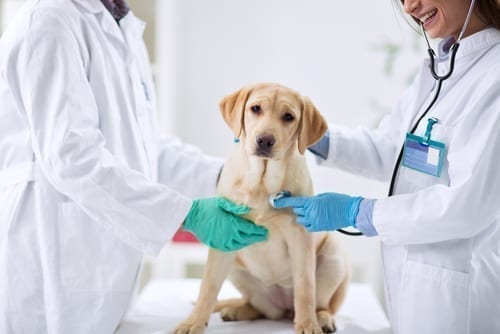What is Minimally Invasive Veterinary Surgery?

Veterinary medicine has often been the pioneer for innovative treatments of disease, as noted with testing of products and medicines on animals before humans. However, laparoscopic surgery, also known as minimally invasive surgery, became the norm in human medicine well before veterinary medicine adopted the technique.
Laparoscopic surgery involves the use of two or three small incisions where tools and cameras are inserted. Gas is injected into the patient’s surgical cavity to allow better visualization and manipulation of organs and tissues. The 5-mm high-definition scope magnifies images x30, providing close inspection of the surgical field as well as recording features to allow for education. Tools are used to dissect and seal various tissues, organs, and vessels, and allow for removal of debris or biopsy specimens.
What Veterinary Procedures Are Commonly Performed with Minimally Invasive Surgery?
Minimally invasive surgery is a safer procedure for pets than traditional surgery. By utilizing smaller incisions and the vessel sealer, veterinarians provide pets a faster recovery time. With a traditional ovariohysterectomy, owners are instructed to keep female dogs crated for a week to 10 days following the procedure, only allowing leash walks to relieve themselves a few times a day. This is to ensure they do not open their incision line. With minimally invasive surgery, female dogs can return to normal activity much faster, generally within a few days of surgery. Sealing vessels replaces internal stitches, which can cause reactions in pets, including itchiness, swelling, and in extreme cases, the need for additional surgery.
Other preventive procedures are safer when performed laparoscopically, such as stomach tacking in young dogs. Certain breeds, such as Great Danes, German Shepherds, Irish Setters, Weimaraners, and more are predisposed to GDV (Gastric Dilation and Volvulus) than others. With gastric dilation and volvulus, the stomach dilates with air and then twists, creating a life-threatening situation. Gastropexy, or suturing the stomach to the body wall, prevents the stomach from twisting. While this does not prevent bloat (stomach dilation), it does allow for less mortality.
How Does Surgery Time Compare?
As with any new technique there will be a learning curve, and in the beginning, surgery time will be a bit longer utilizing the minimally invasive surgery technique as compared to a traditional open technique. However; numerous studies and anecdotal data have shown that minimally invasive surgery time is decreased, which is healthier for our patients and allows more surgeries to be performed in a day.
Why VetOvation for Minimally Invasive Surgery Equipment?
VetOvation = Veterinary Innovation. For years, we have assisted veterinarians in adopting equipment and techniques to provide safer surgery for animals. We constantly strive to improve the equipment we sell so that it is always top of the line while maintaining affordability. Additionally, we provide on-site training, we have a library of training videos online, and we are always a phone call away. Our passion is to help your practice adopt less invasive techniques that will improve your patient’s outcomes. Contact us today to learn more.